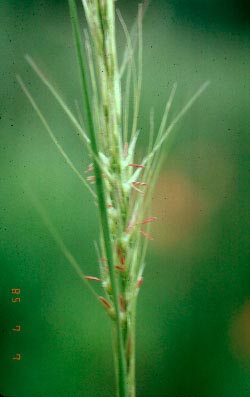Columbia Needlegrass

Common Name(s):
Columbia Needlegrass
Nelson's Needlegrass
Scientific Name:
Achnatherum nelsonii (Scribn.) Barkworth ssp. nelsonii
Scientific Name Synonyms:
Stipa columbiana Macoun var. nelsonii (Scribn.) St. John
Symbol:
ACNE9
Description:
Life Span: Perennial
Origin: Native
Season: Cool
Growth Characteristics: Erect, fine-stemmed bunchgrass, without rhizomes, growing 1 to 2 ½ feet tall, often with purple stem nodes. Starts growth in mid-spring, matures by September, reproduces from seeds and tillers; may regrow in the fall if moisture is adequate.
Seedhead: Narrow, rather dense, often purplish panicle, up to 8 inches longs; spikelets contain one floret; lemmas are hairy with a twice-twisted awn which is usually ¾ to 1 inch long, and attached securely at the tip of the lemma.
Leaves: Blades glabrous, flat when green and growing but rolled when mature, narrow, 4 to 8 inches long; sheaths glabrous; leaves rolled in bud; ligules short, membranous, collar shaped; auricles absent.
Ecological Adaptions:
Columbia needlegrass is a mountain grass that grows at elevations from 5,000 to 12,500 feet where there is more than 15 inches of precipitation per year. It occurs mostly in the mountain and high mountain sites, and can be aggressive, except in water table sites and upland sites. It is common under aspen.
Soils: Grows on a wide variety of soils from shallow to deep, and from sandy loam to clays. It prefers well-developed, deep loamy soils.
Associated Species: Mountain brome, slender wheatgrass, bluebunch wheatgrass, lupine, big sagebrush, aspen, and silver sagebrush.
Uses and Management:
This is a fair to good forage plant for cattle and horses and fair for sheep, deer and elk. It becomes rather unpalatable at maturity. It's seed provides some feed for upland game birds, turkeys, and small mammals. The sharp-pointed callus (part of lemma) may work into the ears, eyes, nostrils, and tongues of grazing animals; sheep are especially susceptible to injury; awns may contaminate the fleece.
The management of this species involves rest from grazing pressure during the flowering and seed formation stage of growth. Proper use for this species is 50 to 60 percent.
Watershed values exist more in terms of the association in which it grows than as an individual species.

